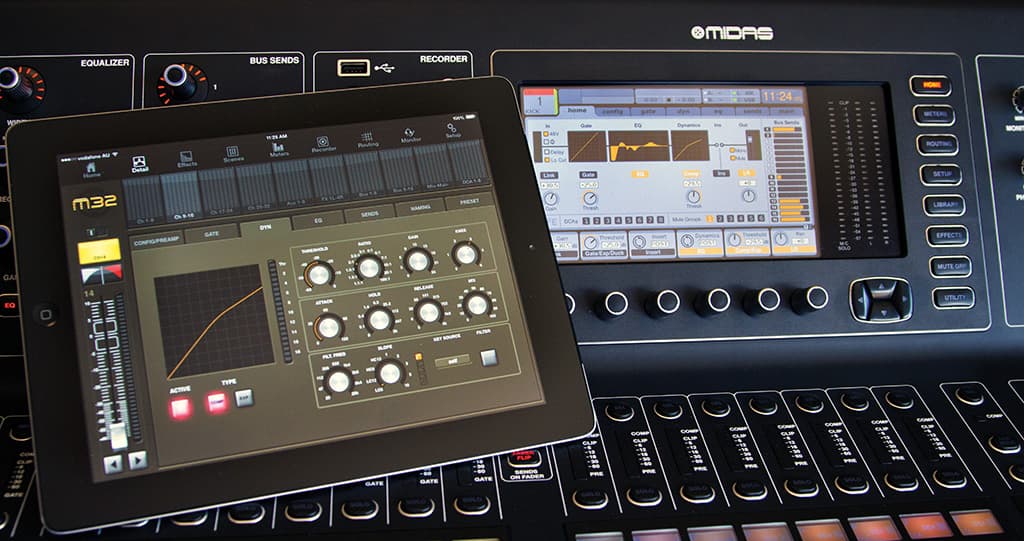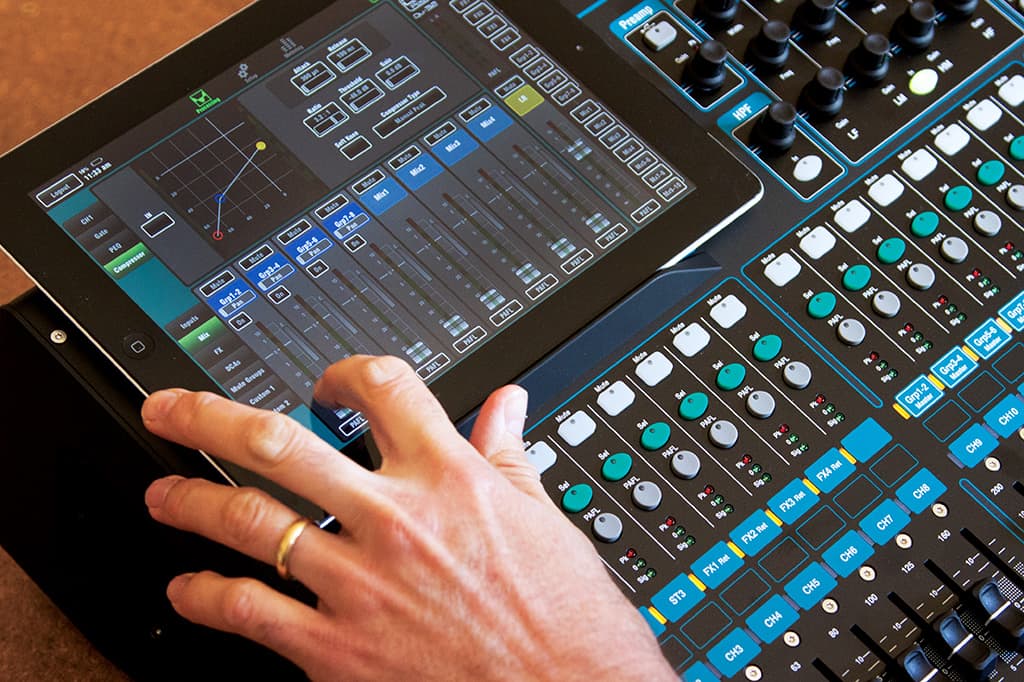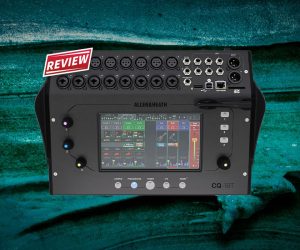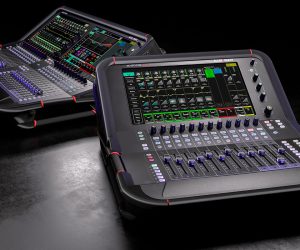
Allen & Heath QU-32 Vs Midas M32
AT’s editorial team takes two new, value-for-money, 32-channel digital mixing consoles for a spin.
Review: Mark Davie & Christopher Holder
The digital console market is in an interesting place right now. Long gone are the days where you had two choices: out-of-reach pro consoles, or severely hobbled compact digital consoles with unworkable latency, arcane user interfaces, tiny monochrome LCDs and serious reliability issues.
Currently, there seems to be three main thrusts to digital console design:
- Cheaper Pro Consoles: Here’s a market that’s chewing up inputs as quickly as manufacturers are adding them to stage boxes. There’s a pressing need for ‘unlimited’ routing flexibility, and having the DSP to chuck processing and EQ at any signal at any time. New consoles, such as A&H GLD, Yamaha QL, Midas Pro series, and others demonstrate you can meet this demand for as low as $30k.
- ‘Stage Box’ Mixers: Mackie started it all with the DL1608 and now Presonus, Behringer, SM Pro (and inevitably others) are following. The idea is to place the console hardware on stage (like a stage box) and mix via your own device.
- Competent Analogue Drop-ins: This relatively new breed of digital console has lots of faders, lots of preamps, and very little need to relearn the craft. The price of the DSP, the motorised faders and the preamps have come down to the point where you can have your digital console looking remarkably like your traditional analogue console.
And here’s where our review begins. Two 32-channel digital mixing consoles that can be considered as drop-in replacements for analogue equivalents. Pull the copper multicore out of your old console, pop it into one of these and off you go.
NEED TO KNOW
Allen & Heath QU-32
NEED TO KNOW
Midas M32
FIRST IMPRESSIONS
Chris: I’ll put my cards on the table and admit that I’m about the only person I know who doesn’t own an X32! Behringer has sold squillions. So I’m coming in to this shootout without a thousand hours of X32 driving under my belt. But immediately the M32 looks way more ‘pro’ than the X32. It’s stealthy. I could imagine the M32 flying deep behind enemy lines without troubling radar.
Mark: Thanks for ’fessing up Chris and I have my own admission to make. This is my first proper look at the A&H Qu platform. If the X32 has been the most popular sub five grand console around then the Qu-16 can’t be that far behind. It’s been a belter for Allen & Heath. It’s easy to see why. I love the bent steel, single angle form factor. There’s also an instant clarity and friendliness about the layout — if the M32 is Darth Vader then the Qu-32 is Obi-Wan.

THE LAYOUT
Mark: Both consoles do the ‘Fat Channel’ thing, with the gain, EQ and dynamics sitting up and to the left of the LCD. I like the fact the Qu-32 has separate Gain/Frequency/Q knobs for each of the four bands. It also uses the console real estate thriftily. What takes the M32 half of its top panel, is only a quarter of the QU-32’s top strip, leaving plenty of room for an iPad rest to the side.
Chris: Agreed, that’s nice. The M32 may require you to toggle through its four bands of parametric EQ, but unlike the Qu-32 my console has LED skirts around the EQ pots which provides some valuable visual feedback without recourse to the LCD. We should add there’s a separate HPF knob on each console.
I’d like to say a word, well two, here about the M32’s scribble strip displays. They’re amazing. Great detail, bright… only bettered by the assignable knob sections where there’s even more resolution. What’s your scribble strip like?
Mark: Ha ha. Old school. ‘Chinagraph and masking tape’ old school, in fact.
Chris: Right! So you make the big leap out of the analogue domain and you’re still actually scribbling?
Mark: I can still name the channels, it’s just not permanently and digitally lit up above the faders. It’s there on the LCD when you select the channel.
Chris: Uh-huh. Metering Mark?
Mark: The metering is very ‘compact analogue’ as well. The age-old three-LED ‘cold, warm, too hot!’ input metering and a 12-step output metering that doubles as PFL solo meters. There’s a separate metering page on the LCD with inputs on one page and outputs on another.
Chris: All sounds a bit miserable compared to my six-LED metering on every channel, plus a gate and comp on/off light. The M32 also has the classic main 24-bar meter, with separate mono solo and stereo main output meters. The TFT display has separate pages for input, output, aux and FX metering, along with a kitchen sink page with everything including P16 output monitoring. Faders?
Mark: They’re your classic ultra-light long-throw Allen & Heath fader. Love them or hate them, A&H are never going to change them. They snap into position extremely quickly in automation.
Chris: Personally I’m a fan of those units after many years on an A&H GL analogue mixer. But saying that, the Midas units are really quite luxurious. They’re one of the key differences between the M32 and the X32.
![M32-Rear_[Print]-pichi](https://www.audiotechnology.com/wp-content/uploads/2015/01/M32-Rear_Print-pichi.png)

M32 I/O: The M32’s I/O is a little more Pro Series in its approach with what looks like a complement of freely assignable inputs and outputs. (Thankfully they’re pre-assigned.) The M32 has eight auxiliary ins and outs along with the 32 mic inputs. The mic amps are intended to handle line level, but we found them unprepared for the hot input from a Fostex CD player/recorder. So best use the aux inputs for hot playback sources. The I/O slot is pre-installed with a USB2.0 card but can take optional MADI, Dante, or ADAT cards.
Qu-32 I/O: Here’s a back panel recognisable to any live sound engineer from the last 40 years. 32 mic/line inputs on XLR and TRS jacks. No direct outs or inserts required here, that’s all covered internally with the USB recording and onboard gates and compressors. Local monitoring outputs are on TRS with a volume pot near the phones output.
Mark: Getting back to the channel strip, do you like the way your bus send section is set up?
Chris: Not especially. I know it adheres to the tradition of having your aux send knobs in the channel strip, but in this regard I think this is where the advantages of digital simply have to override any ‘keeping it old school’ worthy intentions. The M32 has 16 bus sends accessible via four knobs. It works fine but I prefer the Qu-32 approach.
Mark: Which is to have a pushbutton for each bus/mix send to the right of the master fader. Hit the appropriate button and it shows each channel’s contribution to that send on the faders. You can also toggle between two main fader states — all your inputs or all your outputs, with pre-determined LED colour and name switching, easy!
Chris: Exactly. It’s so easy and visually makes so much more sense to me. Admittedly that’s the way the Midas Pro1 does it and that’s what I’m most used to. I should also point out that the M32 has a Fader Flip button that allows you to mix bus sends on the eight centre section faders. So I can get there in the end, but it’s another button you have to press.
Mark: I’m glad you’re so enthusiastic about my console’s approach but I must reluctantly point out one failing: without recourse to the routing page, you can be tricked into thinking you might be sending signal from the vocal channel to the reverb — the send fader is up — when in fact it’s not turned on in the routing page. I found this a little frustrating.
And before we move on, am I the only one who finds it odd that the fat channel is to the left of the LCD and not the other way around? This is true of both consoles: as a right hander my natural inclination is to think it’d be more ergonomic not to have to reach across my body to grab the gain knob while looking at the LCD.
Chris: How do you feel otherwise about general ergonomics?
Mark: I feel good. The flat angled surface of the whole console means it’s relatively comfortable for anyone standing at any height. Sitting works too.
Chris: I’m yet to be totally sold on the M32’s angle on the top panel. The console has to be around belly button height to be comfortable for anyone standing to mix, which would be a little higher than most road cases — although, admittedly I’m 190cm. And when I’m standing at the console, I’m finding myself using my thumb to press buttons on the top panel — which I don’t think is the designers’ intention. I’d suggest the layout has the sedentary engineer in mind more than someone who prefers to stand.
THE DISPLAY
Mark: I win. I have a touchscreen gem. And because it’s a touchscreen the graphics are designed to be big and easy to read at a glance. The layout is coloured to draw your attention to different key elements: red knob for gain, then across the top of the screen is a level meter and gate meter, a relatively large EQ graph you can easily use, and then a comp graph with a knee diagram, with separate gain reduction and output meters. There’s no real-time bouncing dot tracking the input curve but that’d be my only negative observation. Like I said, the Qu-32 screen wins.
Chris: I tend to agree. This is one aspect of the M32 that gets on my goat. The quality of the display is great, but I feel the level of detail is more deserving of its own separate computer screen with a mouse. And any time I see up/down left/right (or let’s call it a NSEW – north, south, east, west) buttons I instantly blanch… this thing needs a mouse or trackball.
Mark: Here’s where the difference between the two consoles are at their most stark I reckon. I have a Home screen with EQ and dynamics on it, and regardless of whether I’m making changes to the hi-mids EQ or the gate, the signal path stays in view — there’s no detailed ‘blown up’ version, just tabs on the lower half to access different parameters.
Chris: While I have to press the View button of the EQ or the compressor, or whatever it is I’m tweaking, to see it on screen. There’s plenty of detail — that’s fantastic — but the screen has the six pots under it that, in the case of the EQ, say, replicate what it already has dedicated knobs for. My question is: Why?
When you’re relying on the screen to change an effects unit or mess about with automation, that’s when it gets tweaky and awkward. The side to side buttons take you up and down at times, and there can be two levels of parameters at the bottom of the screen, which makes things confusing.
Mark: A&H’s approach is about as intuitive as you can get. Press on the screen, and tweak with the single rotary encoder.
Chris: Right, but don’t get too self-satisfied, because the M32 has a secret weapon: its Assignable section. The TFT GUI might be a pain but just about all is forgiven because of these four assignable pots and eight buttons. Combine them with highly detailed scribble displays and you have a very powerful combo. Thanks to the Assignable section you can easily take care of a bunch of otherwise fiddly tasks — like real-time FX tweaks… ramp up a decay time, mute a reverb etc.
What’s more, there are three banks available, so you can potentially have 12 assignable pots and 24 buttons.
Performing arts centres and theatres will love this Assignable section where they’re working on automation-heavy productions and you don’t want to hunt and peck for parameters. The Assignable section works with the scene automation, so each song, act, or band change can have a different set of assignable parameters as you move through the scene changes. Yes, it requires some programming but the rewards are worth it.
Mark: That’s all very impressive. In the Qu-32’s defence it does have 10 SoftKeys for user-assignable functions such as Mute Groups, Tap Tempo, scene navigation or PAFL Clear.
Chris: The M32 has six of its own dedicated mute group buttons in addition to all the other assignable knobbage. And getting back to that, the M32’s LCR routing will also catch the eye of theatres as well. It took me a minute to figure out what the Main Bus pot was for (at the right of the fat channel) but, yes, you have easy independent routing to a mono centre channel.
![_MG_7125_[Print]-pichi](https://www.audiotechnology.com/wp-content/uploads/2015/01/MG_7125_Print-pichi.jpg)

QU-32 SUPER STRIP
A&H calls its ‘fat’ channel a SuperStrip and includes trim, polarity, HPF, gate, insert, four-band parametric EQ, compressor and delay. The main LR and the Mono mixes have controls for Insert, 1/3-octave GEQ, compressor and delay. The stereo mixes provide Insert, four-band parametric EQ, compressor, delay and balance control. The desk houses five cores of ARM processing, with dedicated ARM cores running the touchscreen display and surface, USB streaming, Qu-Drive multi-channel USB recording/playback, Ethernet and fader automation. The DSP architecture employs varied bit depths, tailored to specific algorithms, with 48 bits on critical EQ functions and a 56-bit accumulator on the mix bus.
M32 CHANNEL STRIP
The M32 DSP features 40-bit floating point processing with 40 input channels (32 input channels, six aux and a stereo USB input) and 25 mix buses (16 internal, six matrix and LCR). The 32 input channels have access to all DSP sections and are very well featured. First up is Gain (-12 to +60dB), polarity, channel delay (up to 500ms max), adjustable high-pass filter, and gate/ducker. An insert point is included next which can be set before or after the compressor/expander and EQ (four-band parametric) block. This insert can be routed to the internal effects or physical I/O for external processing. Gates and compressors feature key inputs with filters (hi-pass, lo-pass and band-pass) these can be driven from any channel, aux, effects return or mix bus. The signal path continues through mute, fader and pan (L/R or LCR depending on pan mode). From there, signal can be routed to any of the 16 analogue output buses. The six TRS aux inputs and USB inputs feature a somewhat reduced signal path losing the Gate (gate/ducker) and Dynamics (compressor/expander) sections. The internal effects are simpler again with just mute, fader, pan and bus routing. The main output (L/R, LCR) and buses feature more powerful EQ (six-band parametric), plus a compressor/expander.
AUTOMATION
Mark: We touched on automation. We should probably go into some more detail.
Chris: From an individual channel perspective, there are plenty of M32 factory channel settings: drums, vocals, guitars… and of course you can store your own. Intriguingly there are some ‘signature’ channel presets — ‘Moshe’, ‘Whiskey’, ‘BBM’ — guest engineers lending an ear to my signal path. It’s cool to see someone else’s kick drum EQ but some settings could get a novice into deep water. For example, ‘BBM’ has decided to put a great hacking noise gate on a Female Vocal preset that wreaked havoc. And perhaps ‘Whiskey’s’ 158Hz hi-pass filter and low-mid tonal slaughter is the only way to get a good sound at Whisky A-Go-Go on the Sunset Strip! Not sure.
Mark: Similar deal here without the oddball celebrity presets. By hitting either the gate/EQ/comp sections, you can recall either a global channel setting for the library or a specific setting for that processor. You can also tell it whether you want to recall the preamp setting too. There are only three factory presets for vocal, drum and bass.
You can also store and recall effects settings with separate file structures for User and Factory. Nothing fancy; but very serviceable.
Chris: Looks like both consoles have a similar approach to snapshot automation, where you can lockout certain functions or channels. Saying that, the M32 has dedicated Next and Previous buttons for riffling through the automation pack.
REAL TIME ANALYSERS
Mark: Both consoles have real-time analysers. The Qu-32’s RTA is specifically designed to red flag problem frequency bands. It’s a global RTA that responds to whatever is PFL’d on the input side, not the output. It’s a stereo RTA and presented in bargraphs — 31 bands from 20Hz-20kHz… although curiously the GEQ bands and fader layout only range from 31Hz-16kHz in 28 bands.
Chris: I like the M32’s RTA. It’s always there to be consulted on every input and 100-band resolution provides some very hi-res insight. I regularly work with a headset presenter with some complex sibilance issues and it was good to have some RTA visual feedback when you make some deep hi-Q HF notches.
It’s worth noting that neither console is trying to replace Smaart. Although there’s nothing stopping you from plugging in a measurement mic and taking a measurement of the PA in the room.


THE SOUND
Chris: I have one word for you Mark: XL4 preamps.
Mark: That’s two words, but I know where you’re going with that. So are they the exact same units?
Chris: Apparently. They certainly sound the same as the Pro1 — whisper quiet, plenty of clarity, plenty of panning resolution… lovely.
Mark: The Allen & Heath AnalogIQ preamp is a padless design with loads of gain. It’s a lovely sounding preamp. Admittedly without the fabled Midas euphonic distortion characteristics.
Chris: Yes, thanks for bringing that up Mark. They’re preamps that love to be driven hard for some pleasing fur on the sound. The more expensive Pro1 allows you to drive the analogue gain and then, if necessary, back things off with a digital trim (while retaining the distortion you’re after). The M32 doesn’t immediately make that available – it’s not on the channel strip – which is more of a pain when setting up pre-fade mixes or driving a compressor. However, if you dig a little, there is a page where you can adjust digital trim (it’s primarily designed as a feature that allows more than one surface to ‘gain share’ with the same stage box), it just takes a little more faffing to make it happen. Regardless, these are great preamps and, I would suggest, the single biggest reason why anyone would prefer the M32 to the X32.
Any thoughts about the sound of the EQ or the effects?
Mark: The EQ sounds excellent. Ringing out a wedge or adding some body to an acoustic guitar; it all comes easily. I’m also blown away by the breadth of choice of the effects and processors. It would take me months to form an opinion about them all but it’s certainly a mouth watering prospect marrying your sources to your favourite effects.
Chris: Pultec, UREI, BBE, Lexicon… there are some great effects, EQ and processors in the M32 virtual rack as well. There’s actually more choice than on the Pro1. Many of the FX have been physically modelled. This is all on top of the channel EQ and compression of course.
CONCLUSIONS
Mark: From the top, one of our biggest review criterion was how successful our console is as an analogue drop-in replacement. I’d suggest the Qu-32 wins on that front. If ‘analogue-ness’ is important to you then the Qu-32 is a winner. Yes, there some hidden digital-console depths but anyone can hop on and drive this mixer.
Chris: I’d agree with that. On the other hand, the M32 is an intriguing beast. It’s a hybrid. Music Group (the parent company of Midas and Behringer) has filled a gap in the market, and I’ve no doubt the M32 will win plenty of hearts and minds; but not necessarily of those who are accustomed to Midas digital consoles — this is something different. As far as lineage, the M32 is a Behringer digital console. Thanks to the preamps it sounds like a Midas. Thanks to the faders, it feels like a Midas. But there’s no familial resemblance to any other digital Midas console. This isn’t a criticism, simply an observation.
Mark: There’s something about the Qu-32 that really feels right. For starters, it’s a 32-channel console with 32 faders.
Chris: Ah. Very subtle. While the M32 has 24? That’s true. But the M32 is without question more ‘pro’. For example, if you’re spec’ing a console for a performing arts centre where your bread and butter is weekly/daily changeovers with automation-heavy musical theatre, school groups and eisteddfods, then the M32 wins the day. There’s more pro features: better metering, deeper automation, better channel legending. Otherwise I believe the consoles are neck and neck when it comes to the amount of DSP available — what you can throw at each channel; the effects capabilities, etc.
Mark: And both consoles are very capable with their approach to recording and expandability. And let’s not forget the Qu-32 is cheaper.
Chris: Right. In fact, the Qu-32 is doubtlessly stealing customers from the more affordable X32.
Mark: At this more budget end of the market, do you think there’s much in the name on the badge: Allen & Heath versus Midas?
Chris: They’re both hugely respected names with decades of pedigree. But live sound engineers have made careers out of the Midas preamp. So that’s still not to be underestimated.
Mark: I’m really impressed with the Qu approach. Powerful, uncluttered, easy to use… I wouldn’t hesitate to recommend it to anyone as a no-brainer drop-in replacement for an analogue console. Everyone from rental companies to schools, churches, AV production companies… this is a console in the best traditions of Allen & Heath — an everyman’s mixer that I’ve no doubt will just run and run.
Chris: I have a few reservations about the user interface but can a gazillion X32 sales be wrong? There’s no doubting that this is a powerful, feature-rich console with top spec preamps and faders. And the M32 will certainly reward an owner/operator’s investment of time. Make the M32 your own and you really do have a console that’s worth twice the price.

Review: Allen & Heath QU-16
Read Mark Woods review in AT Issue 97
Review: Behringer X32 Digital Mixing Console
Read Guy Harrison review in AT Issue 91
















Great read, thanks! One queston: you say that the M32’s inputs cannot handle line levels (cd player) very well. Isn’t this adjustable? I want to use the M32 to hook up synths and stuff like that. The manual and specs say that the inputs can handle it…
The Midas has CD/Tape in. All Aux in are Line-In. In our Band alle Keyboards Aux 1-4 and the DJ Desk in Aux 5-6. Some Plugin Effects in the Midas are fantastic (Combinator, Precission).